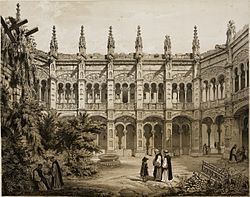 | ||
Similar | ||
The Abbey of Santa Engracia (Spanish: Real Monasterio de Santa Engracia) was a Benedictine monastery in Zaragoza, Aragon, Spain, established no later than the 2nd century, and almost certainly much earlier, to house the relics of Saint Engratia and the many martyrs of Saragossa. The date of 392 was traditionally claimed as a foundation date, which was linked with the travels of Saint Paulinus. The church was believed to have been sited on the spot of the martyrdom of Engratia, and may well originate from the very earliest period of established Islam in Spain.
Contents
Today only remains (crypt and portal) are preserved in the homonym basilica church. It was ruined during the sieges (1808 and 1809) that the Aragonese capital suffered in the Peninsular War by Napoleon Bonaparte, after survived the upper cloister but this was demolished in 1836. Highlighted by its Isabelline and Renaissance's rich architecture.
History
On the Church of the Holy Masses and a few years after Peace of Constantine was allowed built in temple the cemetery of the Martyrs. Until the 4th century its custody was not confided to monks some historians supposes Hieronymites and others Benedictines and there are some who attributes its foundation to Saint Paulinus during his pilgrimage to Zaragoza in 392. The truth is this monastery was already flourishing in 7th century because emerged from it two illustrious prelates: John for the church of Zaragoza and Eugenius for the Toledo. Saint Braulio, son of Zaragoza, brother and successor of the first in the Bishop chair it widened and protected in such way that historians want to pass by its founder.
Surviving the ruin of the Gothic empire continued to be inhabited by monks serving, under the Mohammedan domination, for asylum to the oppressed Christendom to pair to the Basilica di Santa Maria Maggiore. The Catacombs returned to its old destination during the new persecution.
In the Council of Jaca held in year 1063, being Paterno Bishop of Zaragoza, with express consent of its clergy, ceded to the bishopric of Huesca the monastery and church of Santa Engracia and Holy Mass, reiterated donation on 1121 by bull of Pope Gregory VII after the conquest of the capital. But the community would certainly have been extinct since long before because that church belonged as parish of the Cathedral of Huesca, had in it a prior for four centuries which later took the name of archdeacon.
A fortuitous excavation in 1389 discovered the bodies Saint Engratia and Lupercus, in two niches within a mound of stone with their names inscribed that maybe the fear of the Mozarabs who buried them again. Was higher with this the devotion to the Zaragozan noble Virgin and the gratitude of King John II of Aragon "the Great" who believed duty to the miraculous nail of the martyrdom the healing of his cataracts, bequeathed to his son Ferdinand obligation to restore the monastery with the invocation to Saint Engratia.
Fulfilled the vote magnificently the Catholic Monarch in 1493, Saint Engratia's day when the monks took possession and on 6 August of same year the divine services were held in presence of Catholic Monarchs D. Ferdinand and Queen Isabella.
The building was restored around 1755 by Biscayan architect Juan Morlanes, work financed by the payment of 2,500 ducats of Don Clemente Sánchez de Orellana y Riofrío, native from the city of Quito (current Ecuador), which corresponded to price established by the award of the Vicecounty of Antizana (750 ducats) and the Marquisate of Villa de Orellana (1,500 ducats)
With the course of time much of the Gothic building was renovated but the primitive and modern perished all on the night of August 14, 1808 as a result of the terrible explosion that took leave of Zaragoza the hosts of Napoleon to make the second Siege.
Architecture
One of the most famous monuments of this church was the altarpiece and the chapel of the Vicechancellor of Aragon Antonio Agustín, father of the Archbishop of Tarragona of the same name whose work, and the grave of that lord, was executed with great care by famous Berruguete. Collateral to this sepulcher was that of the famous writer and analyst Jerónimo de Zurita, whose epitaph read:
The cloister had a marvelous set of artistic beauties: the grand gallery consists of big columns of marble was work sent to made by emperor Charles V, Holy Roman Emperor to the famous Tudelilla; It looked very ornate of sculptures and paintings by teachers of greater merit: here was the sepulcher of the chronicler of Aragon was Jerónimo de Blancas who died on December 11, 1590. The painting of the main altarpiece and other church paintings were by D. Francisco Bayeu. Only remain standing the famous cover of marble and alabaster whose Plateresque style thinks to be work by Diego Morlanes son of Juan and continuer of the factory.
